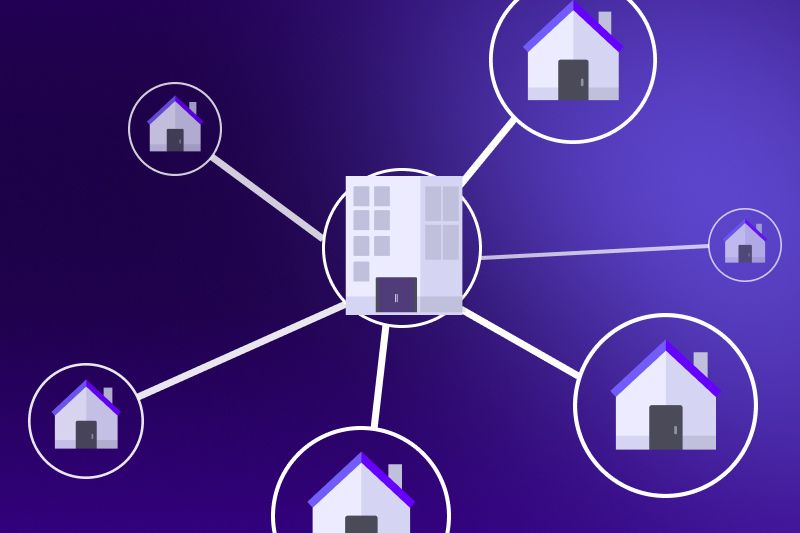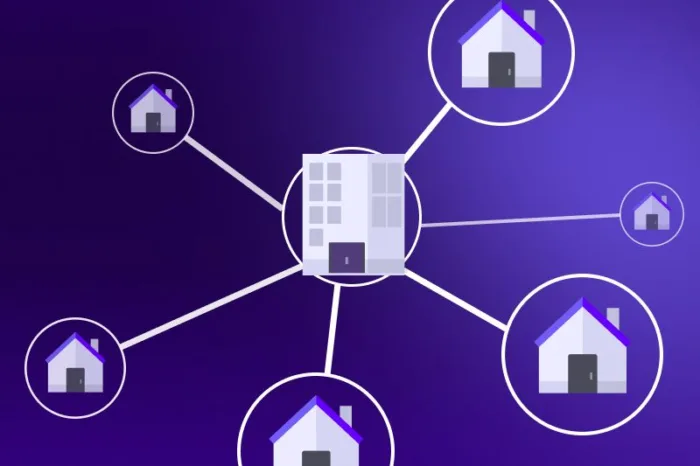Key takeaways
- Multifamily centralization is the process of consolidating property management tasks into a more efficient model.
- Multifamily centralization works by taking your operations off-site with cloud-based software, empowering staff to complete tasks remotely.
- Benefits of a centralized multifamily property include boosted NOI, increased autonomy, and enhanced convenience.
- The best way to centralize your property is to use an all-inclusive property management system like ButterflyMX.

Successful multifamily operations all have one thing in common: efficiency. One of the best ways to achieve true efficiency is to invest in multifamily centralization practices. While multifamily centralization depended heavily on building proximity in the past, the future is much less restrictive.
Below, we describe past models of property centralization. Then, we outline how property technology is helping multifamily centralization evolve, its benefits, and how you can now centralize your property from anywhere
In this post, discover:
- What is centralization in multifamily?
- How does multifamily centralization work?
- What are the benefits of centralization?
- How do you centralize property management?
What is centralization in multifamily?
Multifamily centralization is the practice of consolidating property management tasks into a more efficient model. More specifically, property management centralization creates an efficient operations system without having all aspects on-site.
To understand why this is a big deal, we’ll take a look at the older definition that — with the help of property technology — is a thing of the past.
What multifamily centralization used to mean
Before advancements such as cloud computing, centralization in real estate management simply meant keeping buildings clustered to manage them by proximity.
Then, buildings needed to be close by so that managers and owners could physically visit each location. Likewise, this process made it easier for maintenance personnel to quickly visit the property during emergencies.
But this model came with issues.
For example, say a property manager managed two buildings on opposite sides of town. While working in one, a maintenance worker needs access to another. The manager would have to stop their work and drive across town to unlock the property for the maintenance worker. Because this disruption was so inconvenient, managers and owners limited themselves to nearby properties.
Now that property management is centralized via cloud-based software, owners no longer need to keep their buildings in one location. They are free to place multifamily developments all over the country without sacrificing quality and security.
How does multifamily centralization work?
Multifamily centralization takes your operations off-site with cloud-based software, empowering staff to complete tasks remotely. As a result, you can manage multiple properties, including properties across town or even out of state.
The top aspects of a centralized property management system include:
- Centralized leasing. Centralized automated leasing automates the life cycle of processing a prospective resident. When leasing is centralized, their information is put into the database where leasing agents can access it. From there, all information from the application to the signed lease is available and ready to use.
- Online dashboards. Cloud-based software enables property managers to access everything they need on the dashboard (or online portal). These dashboards host data about tenants, visitors, vacancy rates, and maintenance requests.
- Virtual/self-guided tours. With a centralized system, property managers are no longer expected to be on-site to give prospects tours of the property.
- Manage amenity reservations. Empower residents to browse amenity spaces and make reservations from anywhere at any time with a mobile app.
What are the benefits of centralization?
There are many benefits to a centralized property management system, specifically efficiency. But what are the specific benefits to this increased efficiency?
The benefits of multifamily centralization include:
1. Boosted NOI
Residents expect convenience, and by providing that, you can easily benefit from their satisfaction and boost your net operating income. Moreover, a greater NOI means room for more improvements.
Property technology that assists centralization and boosts NOI include:
- Access control systems. Access control not only enhances security but also increases convenience for residents. With the right system, they’re empowered to enter their buildings without hassle and grant access to their visitors from anywhere. Further, a robust access control system allows managers and owners to grant access from anywhere — including to service workers who need to fix maintenance emergencies during off hours.
- Resident management platforms. A resident management platform centralizes communication, maintenance requests, and rent payments in one place. This makes it easy for residents to communicate with property managers using one source. As a result, you and your tenants can handle all issues from a single platform.
- Mobile app. Mobile apps are the biggest positive change for residents and managers. Everyone enjoys the flexibility of accessing a user portal from their cell phone. What’s more, mobile phone apps can even help residents and staff with property access management to the building. The best access control systems come with their own mobile app that allows tenants and staff to grant Visitor Passes and swipe-to-open.
Discover the secrets to multifamily centralization:
2. Increased autonomy
Previously, staff, property managers, and residents were dependent on location-based services and benefits. However, with the advancement in centralizing technology, each building within a development is fully autonomous — while still operating as a cohesive unit.
Furthermore, this makes it easier for properties to operate as efficiently as possible in the environment it’s in. For example, maintenance costs will vary between locations but will never interfere with another property’s operations.
Additionally, say you’re stationed in Arizona but own additional multifamily property in Illinois. You’ll likely never face a snowstorm at home, but your tenants and staff in the Midwest will. By centralizing your properties, your Illinois property can take appropriate measures to protect against the harsh winters without affecting the maintenance cost of your residents in Arizona.
3. Enhanced convenience
Centralized technology, such as access control systems, is the perfect asset for enhancing convenience for residents.
A centralized building will make it easier for residents to:
- Anticipate and monitor upcoming deliveries — residents will no longer miss or lose packages.
- Receive video calls from guests and visitors, enabling tenants to see requests before allowing or denying entry.
- Use their smartphone as a credential to enter the front door as well as amenity spaces and their unit.
Furthermore, convenience from access control centralization extends to property managers and staff. Among other features, centralized technology empowers managers to remotely view and monitor visitors using a time-and-date-stamped photo log on the dashboard.
How do you centralize property management?
The best way to centralize your property is to use a cloud-based access management system like ButterflyMX. ButterflyMX is the first end-to-end property automation system that streamlines access, starting from the front gate and continuing to the resident’s unit.
ButterflyMX products
Products within the ButterflyMX ecosystem include:
- Video Intercom. Our Video Intercom allows you to let in visitors remotely, no matter where you are — just use our smartphone app. With features like Visitor Passes and multiple electronic credentials, centralizing management platforms on your property has never been easier.
- Security Cameras. Choose between our Dome and Bullet Cameras to secure indoor and outdoor spaces. Plus, view live feeds and sort through crucial videos with our powerful ButterflyMX OS.
- Front Desk Station. The front desk station from ButterflyMX is a visitor management software that can be loaded onto your organization’s computer. This software enables you to monitor movement in your building via a live video stream — increasing overall security. Moreover, you can also interact with guests using the video intercom system, also from ButterflyMX.
- Amenity reservation platform. Empower residents to reserve building amenities at any time by allowing them to easily check space availability and associated fees, and book amenities for themselves and their guests via the ButterflyMX app. With this feature, property staff can configure their amenity spaces in our cloud-based dashboard in just a few clicks.
- Elevator Controls. With this feature, residents don’t have to keep multiple key fobs and cards for several different entry methods. They can unlock the front door, their unit’s door, and a key-fobbed elevator — all from our top-rated mobile app.
- Package Rooms. The Package Room, equipped with the ButterflyMX wide-angle Video Intercom, simplifies package management for tenants and staff. With a designated PIN, deliverers can leave packages in the room, and residents can retrieve them when they’re ready.
- Top-rated mobile app. With our top-rated smartphone app, residents can find everything they need. This includes a swipe-to-open button for a touchless entry experience and a two-way video where they can see anyone requesting entry access. Further, in the mobile app, you can video chat with visitors and maintenance workers and grant them access from anywhere in the world.







